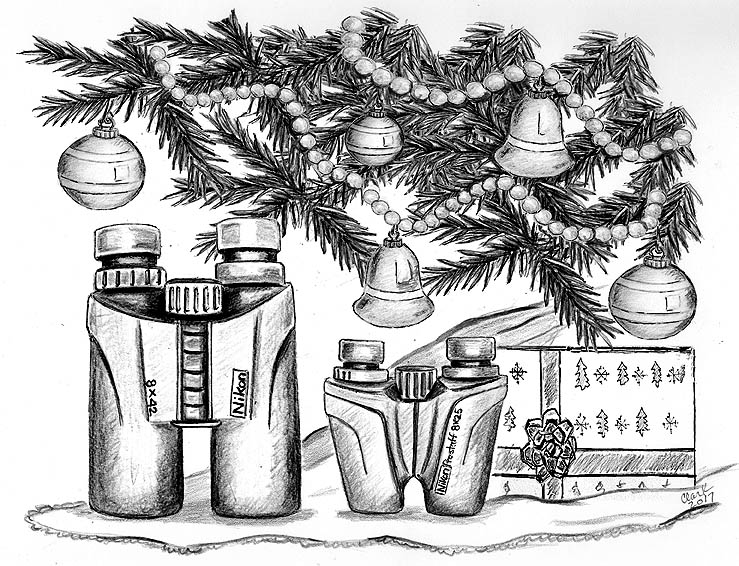
Choosing Binoculars:
I wrote about this topic a few years ago, but judging from the continuous questions I receive on this subject, I need to do it again. Apparently, no one read what I wrote the first time. Either that or I didn’t do a good job of explaining things. I sure hope it’s the first reason, because if no one understood me before, it probably won’t be any clearer this time around. But first, I want to point out that this advice is intended for novices and for folks who are perhaps getting (or giving) their first pair of binoculars. This isn’t for hardcore birders. When it comes to binoculars, birders already know all there is to know…or at least they think they do.
My first suggestion may appear to be sexist, but that’s only because it probably is. If you (the generic “you”) are thinking about buying new binoculars for a spouse, friend or sibling, you should take into account that particular person’s sex, which I assume you already know. Sexist or not the vast majority of my female customers prefer smaller binoculars. Conversely, men tend to gravitate to larger binoculars. In reality, this is not a gender thing; it has more to do with body size (but saying it’s sexist gets everyone’s attention). People with large hands (mainly guys) usually don’t feel comfortable holding tiny binoculars, while smaller folks (mostly gals) typically hate those “clunky things.” There are exceptions, but not many.
The next feature to consider is magnification. Thankfully, choosing proper magnification is not sexist at all…it’s ageist. When I first started birding, I used strong ten-power (10X) binoculars and loved them. Ten-power made the birds nice and large. But as I grew older, my hands became less steady and now high-powered optics makes the birds blurry. When I switched to a lower magnification (8X), the birds became slightly smaller, but much clearer. With that in mind, if you are buying binoculars for someone pushing middle age or beyond, eight-power will do a better job for him or her. Just don’t mention the age thing. It will spoil the mood.
Note:
A few companies make binoculars with built-in electronic image stabilization. I’ve tried these binoculars at trade shows and found them to work pretty well. However, they tend to be bulky and very expensive. Also, I rarely see birders using electronic binoculars in the field, which should tell you something. If this were a worthwhile product, every birder would have one…and maybe two.
Speaking of expensive: After size and magnification, the next important question is how much does a decent pair of binoculars cost? This is where the arguments really happen. Serious birders insist on having the best binoculars they can afford, and sometimes more than they can afford. I’ve seen people dish out over three grand for a single pair of binoculars and that’s okay, since their hobby is very important to them. Plus, birding is still cheaper than, say, collecting vintage Corvettes (perhaps not as cool, but certainly cheaper). If you are buying binoculars for a backyard bird watcher, you really don’t need to spend much more than a hundred bucks or so. Does spending more money make a difference? Yes, but it’s all relative. Binoculars costing five times more will produce a better image, but it won’t be five times better. Price improves optics in very slight and very expensive increments. And now even binoculars in the “affordable” range are waterproof and have adjustable eyecups for eyeglass wearers. Both of these features are important to have, especially if you wear glasses or like to use binoculars in the shower.
Which brand of binoculars do I recommend? That’s totally up to you, but choose a brand with a recognizable name. I wouldn’t buy a pair of “Bud’s Super-Viewers” just because they are on sale and stacked next to the checkout register. Also, stay away from gimmicks, such as binoculars with zoom lenses. What are zoom lenses? Some companies sell binoculars with a small lever that allows you to increase the magnification, or zoom-in on your subject. On paper, that seems like a good idea. It’s not. These types of binoculars tend to produce inferior images and have the habit of breaking easily. Also, don’t be tricked into buying something called “focus-free” binoculars. Everybody’s eyes are different and thus the binoculars you use need to be adjusted accordingly. Using binoculars with no focusing mechanism is like using someone else’s eyeglasses. They are a headache in waiting. Besides, anyone too lazy to turn a focus wheel probably won’t have enough ambition to go for a bird walk.
A lot of experts assert that new birders should start off with high-end optics, but I disagree (especially if I’m paying for them). Good, reasonably priced binoculars are what most of us got started with. Yes, we may have eventually invested in a fancier pair, but we all kept the originals for back up or to share with a newbie.
In summary: Based on my experience, 8X is the safest magnification to choose and compact binoculars tend to be popular with the petite crowd. Finally, I recommend you spend at least $100, and more if you can afford it. And if you are in the mood to give someone a pair of binoculars that cost over three grand, keep me in mind. I wouldn’t mind having a secret Santa.